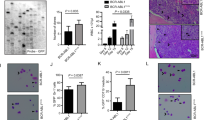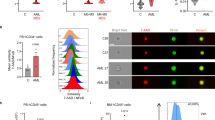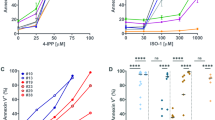Abstract
Bone-marrow minimal residual disease (MRD) causes relapse after chemotherapy in patients with acute myelogenous leukemia (AML). We postulate that the drug resistance is induced by the attachment of very late antigen (VLA)-4 on leukemic cells to fibronectin on bone-marrow stromal cells. We found that VLA-4-positive cells acquired resistance to anoikis (loss of anchorage) or drug-induced apoptosis through the phosphatidylinositol-3-kinase (PI-3K)/AKT/Bcl-2 signaling pathway, which is activated by the interaction of VLA-4 and fibronectin. This resistance was negated by VLA-4-specific antibodies. In a mouse model of MRD, we achieved a 100% survival rate by combining VLA-4-specific antibodies and cytosine arabinoside (AraC), whereas AraC alone prolonged survival only slightly. In addition, overall survival at 5 years was 100% for 10 VLA-4-negative patients and 44.4% for 15 VLA-4-positive patients. Thus, the interaction between VLA-4 on leukemic cells and fibronectin on stromal cells may be crucial in bone marrow MRD and AML prognosis.
This is a preview of subscription content, access via your institution
Access options
Subscribe to this journal
Receive 12 print issues and online access
$209.00 per year
only $17.42 per issue
Buy this article
- Purchase on Springer Link
- Instant access to full article PDF
Prices may be subject to local taxes which are calculated during checkout






Similar content being viewed by others
References
Ohno, R. et al. Randomized study of individualized induction therapy with or without vincristine, and of maintenance-intensification therapy between 4 or 12 courses in adult acute myeloid leukemia. Cancer 71, 3888–3895 (1993).
Hann, I.M. et al. Randomized comparison of DAT versus ADE as induction chemotherapy in children and younger adults with acute myeloid leukemia. Results of the Medical Research Council's 10th AML trial (MRC AML10). Adult and Childhood Leukaemia Working Parties of the Medical Research Council. Blood 89, 2311–2318 (1997).
Lowenberg, B., Downing, J.R. & Burnett, A. Acute myeloid leukemia. N. Engl. J. Med. 341, 1051–1062 (1999).
Preisler, H.D. et al. The frequency of long-term remission in patients with acute myelogenous leukaemia treated with conventional maintenance chemotherapy: a study of 760 patients with a minimal follow-up time of 6 years. Br. J. Haematol. 71, 189–194 (1989).
Garson O.M. et al. Cytogenetic studies of 103 patients with acute myelogenous leukemia in relapse. Cancer Genet. Cytogenet. 40, 187–202 (1989).
Bendall, L.J. et al. Stem cell factor enhances the adhesion of AML cells to fibronectin and augments fibronectin-mediated anti-apoptotic and proliferative signals. Leukemia 12, 1375–1382 (1998).
Bendall, L.J., Kortlepel, K. & Gottlieb, D.J. Human acute myeloid leukemia cells bind to bone marrow stroma via a combination of β-1 and β-2 integrin mechanisms. Blood 82, 3125–3132 (1993).
Allouche, M. et al. Ligation of the CD44 adhesion molecule inhibits drug-induced apoptosis in human myeloid leukemia cells. Blood 96, 1187–1190 (2000).
Charrad, R.S. et al. Ligation of the CD44 adhesion molecule reverses blockage of differentiation in human acute myeloid leukemia. Nat. Med. 5, 669–676 (1999).
Charrad, R.S. et al. Effects of anti-CD44 monoclonal antibodies on differentiation and apoptosis of human myeloid leukemia cell lines. Blood 99, 290–299 (2002).
Legras, S. et al. A strong expression of CD44-6v correlates with shorter survival of patients with acute myeloid leukemia. Blood 91, 3401–3413 (1998).
de la Fuente, M.T. et al. Fibronectin interaction with α4β1 integrin prevents apoptosis in B cell chronic lymphocytic leukemia: correlation with Bcl-2 and Bax. Leukemia 13, 266–274 (1999).
Andreeff, M. et al. Expression of Bcl-2-related genes in normal and AML progenitors: changes induced by chemotherapy and retinoic acid. Leukemia 13, 1881–1892 (1999).
Tudor, G. et al. Susceptibility to drug-induced apoptosis correlates with differential modulation of Bad, Bcl-2 and Bcl-XL protein. Cell Death Differ. 7, 574–586 (2000).
Aoudjit, F. & Vuori, K. Integrin signaling inhibits paclitaxel-induced apoptosis in breast cancer cells. Oncogene 20, 4995–5004 (2001).
Kobayashi, T. et al. Randomized trials between behenoil cytarabine and cytarabine in combination induction and consolidation therapy, and with or without ubenimex after maintenance/intensification therapy in adult acute myeloid leukemia. J. Clin. Oncol. 14, 204–213 (1996).
Grimwade, D. et al. The importance of diagnostic cytogenetics on outcome in AML: analysis of 1,612 patients entered into the MRC AML 10 trial. The Medical Research Council Adult and Children's Leukaemia Working Parties. Blood 92, 2322–2333 (1998).
Lapidot, T. et al. A cell initiating human acute myeloid leukaemia after transplantation into SCID mice. Nature 367, 645–648 (1994).
Bonnet, D. & Dick, J.E. et al. Human acute myeloid leukemia is organized as a hierarchy that originates from a primitive hematopoietic cell. Nat. Med. 3, 730–737 (1997).
Sugahara, H. et al. Induction of programmed cell death in human hematopoietic cell lines by fibronectin via its interaction with very late antigen 5. J. Exp. Med. 179, 1757–1766 (1994).
Yang, F.C. et al. Rac2 stimulates Akt activation affecting BAD/Bcl-XL expression while mediating survival and actin function in primary mast cells. Immunity 12, 557–568 (2000).
Kapur, R. et al. Cross-talk between alpha(4)beta(1)/alpha(5)beta(1) and c-Kit results in opposing effect on growth and survival of hematopoietic cells via the activation of focal adhesion kinase, mitogen-activated protein kinase, and Akt signaling pathways. Blood 97, 1975–1981 (2001).
Damiano, J.S. et al. Cell adhesion mediated drug resistance (CAM-DR): Role of integrins and resistance to apoptosis in human myeloma cell lines. Blood 93, 1658–1667 (1999).
Mudry, R.E. et al. Stromal cells regulate survival of B-lineage leukemic cells during chemotherapy. Blood 96, 1926–1932 (2000).
Elices, M.J. et al. VCAM-1 on activated endothelium interacts with the leukocyte integrin VLA4 at a site distinct from the VLA4/fibronectin binding site. Cell 60, 577–584 (1990).
Gilmore, A.P., Metcalfe, A.D., Romer, L.H. & Streuli, C.H. Integrin-mediated survival signals regulate the apoptotic function of Bax through its conformation and subcellular localization. J. Cell Biol. 149, 431–436 (2000).
Khwaja, A. et al. Matrix adhesion and Ras transformation both activate a phosphoinositide 3-OH kinase and protein kinase B/Akt cellular survival pathway. EMBO J. 16, 2783–2793 (1997).
King, W.G. et al. Phosphatidylinositol 3-kinase is required for integrin-stimulated AKT and Raf-1/mitogen-activated protein kinase pathway activation. Mol. Cell Biol. 17, 4406–4418 (1997).
Chen, Q. et al. Integrin-mediated cell adhesion activates mitogen-activated protein kinases. J. Biol. Chem. 269, 26602–26605 (1994).
Moro, L. et al. Integrins induce activation of EGF receptor: role in MAP kinase induction and adhesion-dependent cell survival. EMBO J. 17, 6622–6632 (1998).
Aoudjit, F. et al. Matrix attachment regulates Fas-induced apoptosis in endothelial cells: a role for c-flip and implications for anoikis. J. Cell Biol. 152, 633–643 (2001).
Miyake, K. et al. Requirement for VLA-4 and VLA-5 integrins in lymphoma cells binding to and migration beneath stromal cells in culture. J. Cell Biol. 119, 653–662 (1992).
Hemler, M.E. et al. VLA proteins in the integrin family: structures, functions, and their role on leukocytes. Annu. Rev. Immunol. 8, 365–400 (1990).
Kamata, T. et al. Identification of putative ligand-binding sites of the integrin alpha 4 beta 1 (VLA-4, CD49d/CD29). Biochem. J. 305, 945–951 (1995).
Akiyama, S.K., Yamada, S.S., Chen, W.T. & Yamada, K.M. Analysis of fibronectin receptor function with monoclonal antibodies: roles in cell adhesion, migration, matrix assembly, and cytoskeletal organization. J. Cell Biol. 109, 863–875 (1989).
Irie, A. et al. Critical amino acid residues for ligand binding are clustered in a predicted beta-turn of the third N-terminal repeat in the integrin alpha 4 and alpha 5 subunits. EMBO J. 14, 5550–5556 (1995).
Kawano, Y. et al. Ex vivo expansion of human umbilical cord hematopoietic progenitor cells using a coculture system with human telomerase catalytic subunit (hTERT)-transfected human stromal cells. Blood 101, 532–540 (2003).
Kawada, H. et al. Rapid ex vivo expansion of human umbilical cord hematopoietic progenitors using a novel culture system. Exp. Hematol. 27, 904–915 (1999).
Lacombe, F. et al. Flow cytometry CD45 gating for immunophenotyping of acute myeloid leukemia. Leukemia 11, 1878–1886 (1997).
Furukawa, K. et al. Neuroprotective action of cycloheximide involves induction of Bcl-2 and antioxidant pathways. J. Cell Biol. 136, 1137–1149 (1997).
Sasaki, H. et al. Induction of heat shock protein 47 synthesis by TGF-β and IL-1β via enhancement of the heat-shock binding activity of heat-shock transcription factor 1. J. Immunol. 168, 5178–5183 (2002).
Yoshino, H. et al. Natural killer cell depletion by anti-asialo GM1 antiserum treatment enhances human hematopoietic stem cell engraftment in NOD/Shi-scid mice. Bone Marrow Transplant. 25, 1211–1216 (2000).
Almedia-Porada, G. et al. Differentiative potential of human metanephric mesenchymal cells. Exp. Hematol. 30, 1454–1462 (2002).
Garcia-Meunier, P. et al. Concerted evolution in the GAPDH family of retrotransposed pseudogenes. Mammalian Genome 4, 695–703 (1993).
Zhang, Y. et al. Murine sclerodermatous graft-versus-host disease, a model for human scleroderma: cutaneous cytokines, chemokines, and immune cell activation. J. Immunol. 168, 3088–3098 (2002).
Heinze, G. & Schemper, M. Comparing the importance of prognostic factors in Cox and logistic regression using SAS. Comput. Meth. Prog. Biomed. 71, 155–163 (2003).
Acknowledgements
The authors thank P. Olley and K. Litton for editorial assistance.
Author information
Authors and Affiliations
Corresponding author
Ethics declarations
Competing interests
The authors declare no competing financial interests.
Supplementary information
Rights and permissions
About this article
Cite this article
Matsunaga, T., Takemoto, N., Sato, T. et al. Interaction between leukemic-cell VLA-4 and stromal fibronectin is a decisive factor for minimal residual disease of acute myelogenous leukemia. Nat Med 9, 1158–1165 (2003). https://doi.org/10.1038/nm909
Received:
Accepted:
Published:
Issue Date:
DOI: https://doi.org/10.1038/nm909
This article is cited by
-
A novel therapeutic strategy: the significance of exosomal miRNAs in acute myeloid leukemia
Medical Oncology (2024)
-
Modelling acute myeloid leukemia (AML): What’s new? A transition from the classical to the modern
Drug Delivery and Translational Research (2023)
-
The genesis and evolution of acute myeloid leukemia stem cells in the microenvironment: From biology to therapeutic targeting
Cell Death Discovery (2022)
-
VCAM1 confers innate immune tolerance on haematopoietic and leukaemic stem cells
Nature Cell Biology (2022)
-
Graphdiyne oxide nanosheets display selective anti-leukemia efficacy against DNMT3A-mutant AML cells
Nature Communications (2022)



